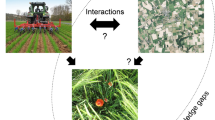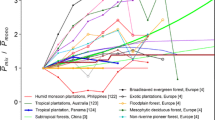Abstract
Relationships involving fire and perennial grasses are controversial in Chihuahuan Desert grasslands of southern New Mexico, USA. Research suggests that fire delays the resprouting of perennial grasses well after two growing seasons. However, such results are confounded by livestock grazing, soil erosion, and drought. Additionally, post-fire grass responses may depend on initial clone size. We evaluated the effects of fire, grazing, and clone size on Bouteloua eriopoda (black grama) in southern New Mexico grasslands. Four 2-ha plots were established in each of four sites. Fire and grazing were applied or not applied in 1999 such that four treatment combinations were assigned randomly to plots within each site. Within each plot, small (0–10 cm2 basal area), medium (10–30 cm2), and large ( > 30 cm2) clones were initially mapped in five 0.91-m2 quadrats where grass attributes and litter cover were evaluated before and at the end of two growing seasons following fire. Maximum fire temperature was also measured. At a population level, canopy and litter cover were each approximately 50% less in burned than unburned areas. However, compared to initial levels, canopy height had increased by 10% at the end of the study, regardless of fire. At a clonal level, basal cover reductions were attributed mostly to large clones that survived fire. Smaller clone densities had decreased by as much as 19% in burned compared to unburned areas, and fire reduced the basal cover of medium clones. Basal and canopy cover, recruitment, and clone basal area decreased with increased fire temperatures. Almost all responses were independent of grazing, and interactive effects of grazing and fire were not detected. Fire did not kill all perennial grass clones, regardless of size. However, rapid responses were likely influenced by above-average precipitation after fire. Future studies in desert grasslands should examine how perennial grass dynamics are affected by fire, precipitation patterns, and interactions with grazing.





Similar content being viewed by others
References
Alexander ME (1982) Calculating and interpreting forest fire intensities. Can J Bot 60:349–357
Bonham CD (1989) Measurements for terrestrial vegetation. John Wiley & Sons, New York
Briggs JM, Knapp AK (1995) Interannual variability in primary production in tallgrass prairie: climate, soil moisture, topographic position and fire as determinants of aboveground biomass. Am J Bot 82:1024–1030
Buffington LC, Herbel CH (1965) Vegetational changes on a semidesert grassland range from 1858 to 1963. Ecol Monogr 35:139–164
Byram GM (1959) Combustion of forest fuels. In: Davis KP (eds) Forest fire: control and use. McGraw-Hill, New York, pp 61–89
Cable DR (1965) Damage to mesquite, lehmann lovegrass and black grama by a hot June fire. J Range Manage 18:326–329
Cable DR (1967) Fire effects on semidesert grasses and shrubs. J Range Manage 20:170–176
Collins SL (1987) Interaction of disturbances in tallgrass prairie: a field experiment. Ecology 68:1243–1250
De Luis M, Raventos J, Cortina J, Gonzalez-Hidalgo JC, Sanchez JR (2004) Fire and torrential rainfall: effects on the perennial grass Brachypodium retusum. Plant Ecol 173:225–232
Dick-Peddie WA (1993) New Mexico vegetation past, present, and future. University of New Mexico Press, Albuquerque
Drewa PB (2003) Effects of fire season and intensity on Prosopis glandulosa Torr. var. glandulosa. Int J Wildland Fire 12:147–157
Drewa PB, Havstad KM (2001) Effects of fire, grazing, and the presence of shrubs on Chihuahuan Desert grasslands. J Arid Environ 48:429–443
Drewa PB, Peters DPC, Havstad KM (2001) Fire, grazing, and honey mesquite invasion in black grama-dominated grasslands of the Chihuahuan Desert: a synthesis. In: Wilson TP, Galley KEM (eds) Proc Invasive Species Workshop: the role of fire in the control and spread of invasive species. Fire Conf 2000: 1st Natl Cong Fire Ecol Prevention Manage. Tall Timbers Res Stn, Misc. Publ No. 11, Tallahassee, Fla., pp 31–39
Drewa PB, Platt WJ, Moser EB (2002) Fire effects on resprouting of shrubs in headwaters of southeastern longleaf pine savannas. Ecology 83:755–767
Engle DM, Bidwell TG (2001) The response of central North American prairies to seasonal fire. J Range Manage 54:2–10
Gibbens RP, Herbel CH, Morton HL, Lindemann WC, Ryder-White JA, Richman DB, Huddleston EW, Conley WH, Davis CA, Reitzel JA, Anderson DM, Guiao A (1986) Some impacts of 2,4,5-T on a mesquite duneland ecosystem in southern New Mexico: a synthesis. J Range Manage 39:320–326
Gosz JR, Moore DI, Shore GA, Grover HD (1995) Lightning estimates of precipitation location and quantity on the Sevilleta LTER, New Mexico. Ecol Appl 5:1141–1150
Gould FW (1979) The genus Bouteloua (Poaceae). Ann Mo Bot Gard 66:348–416
Grace SL, Platt WJ (1995) Effects of adult tree density and fire on the demography of pregrass stage juvenile longleaf pine (Pinus palustris Mill.). J Ecol 83:75–86
Hobbs RJ, Currall JEP, Gimingham CH (1984) The use of thermocolor pyrometers in the study of heath fire behavior. J Ecol 72:241–250
Knapp AK, Hulbert LC (1986) Production, density, and height of flower stalks of three grasses in annually burned and unburned eastern Kansas tallgrass prairie: a four-year record. Southwest Nat 31:235–241
McFarland JB, Mitchell R (2000) Fire effects on weeping lovegrass tiller density and demographics. Agron J 92:42–47
McPherson GR (1995) The role of fire in the desert grasslands. In: McClaran MP, van Devender TR (eds) The desert grassland. The University of Arizona Press, Tucson, pp 130–151
Miyanishi K, Kellman M (1986) The role of fire in recruitment of two neotropical savanna shrubs, Miconia albicans and Clidemia sericea. Biotropica 18:224–230
Mulligan MK, Kirkman LK (2002) Burning influences on wiregrass (Aristida beyrichiana) restoration plantings: natural seedling recruitment and survival. Restor Ecol 10:334–339
Natural Resources Conservation Service (2005) National range and pasture handbook. (http://www.glti.nrcs.usda.gov/technical/publications/nrph.html). USDA, Washington D.C.
Paulsen HA Jr, Ares FN (1962) Grazing values and management of black grama and tobosa grasslands and associated shrub ranges of the Southwest. USDA, Technical Bulletin No. 1270, Washington D.C.
Pelaez DV, Boo RM, Elia OR, Mayor MD (1997) Effect of fire intensity on bud viability of three grass species native to central semi-arid Argentina. J Arid Environ 37:309–317
Pelaez DV, Boo RM, Mayor MD, Elia OR (2001) Effect of fire on perennial grasses in central semiarid Argentina. J Range Manage 54:617–621
Platt WJ, Glitzenstein JS, Streng DR (1991) Evaluating pyrogenicity and its effects on vegetation in longleaf pine savannas. Proc Tall Timbers Fire Ecol Conf 17:143–161
Radford IJ, Nicholas DM, Brown JR (2001) Impact of prescribed burning on Acacia nilotica seed banks and seedlings in the Astrebla grasslands of northern Australia. J Arid Environ 49:795–807
Reynolds HG, Bohning JW (1956) Effects of burning on a desert grass-shrub range in southern Arizona. Ecology 37:769–777
Rogers GF, Vint MK (1987) Winter precipitation and fire in the Sonoran Desert. J Arid Environ 13:47–52
Rossiter NA, Setterfield SA, Douglas MM, Hutley LB (2003) Testing the grass-fire cycle: alien grass invasion in the tropical savannas of northern Australia. Divers Distrib 9:169–176
SAS (2001) SAS/STAT users guide. SAS Institute, Cary, N.C.
Scarnecchia DL (1985) The animal-unit and animal-unit-equivalent concepts in range science. J Range Manage 38:346–349
Schimmel J, Granstrom A (1996) Fire severity and vegetation response in the boreal Swedish forest. Ecology 77:1436–1450
Schlesinger WH, Reynolds JF, Cunningham GL, Huenneke LF, Jarrell WM, Virginia RA, Whitford WG (1990) Biological feedbacks in global desertification. Science 247:1043–1048
Schmid MK, Rogers GF (1985) Trends in fire occurrence in the Arizona upland subdivision of the Sonoran Desert, 1955–1983. Southwest Nat 33:437–444
Sparks JC, Masters RE, Engle DM, Palmer MW, Bukenhofer GA (1998) Effects of late growing-season and late dormant-season prescribed fire on herbaceous vegetation in restored pine-grassland communities. J Veg Sci 9:133–142
USDA-NRCS (2004) The PLANTS database, version 3.5 (http://www.plants.usda.gov). National Plant Data Center, Baton Rouge, La.
Uys RG, Bond WJ, Everson TM (2004) The effect of different fire regimes on plant diversity in southern African grasslands. Biol Conserv 118:489–499
Valone TJ, Kelt DJ (1999) Fire and grazing in a shrub-invaded arid grassland community: independent or interactive ecological effects? J Arid Environ 42:15–28
Vesk PA, Warton DI, Westoby M (2004) Sprouting by semi-arid plants: testing a dichotomy and predictive traits. Oikos 107:72–89
York JC, Dick-Peddie WA (1969) Vegetation changes in southern New Mexico during the past hundred years. In: McGinnies WG, Goldman BJ (eds) Arid lands in perspective. The University of Arizona Press, Tucson, pp 155–166
Acknowledgements
Numerous people helped with field work and treatment applications, including Rob Dunlap, Eddie Garcia, Sarah Goslee, Roy Libeau, John Smith, and especially Jim Lenz and David Thatcher. In addition, Terese Flores, Mendy Fowler, and Ruth Sedillo prepared sets of fire temperature tablets. We are grateful to Leigh Murray, University Statistics Center, New Mexico State University, for assisting with the data analyses, and Sandra Albro Rutter for refining the presentation of some figures. Thanks are extended to Joel Brown, Matt Dickinson, Bob Gibbens, Jeff Herrick, Charles Kwit, Bill Platt, and Justin van Zee for helpful discussions of ideas. We are also grateful to two anonymous reviewers who provided very helpful comments on the manuscript. This study was funded through contract 1422-R220A8-0023 from the USDI, Bureau of Land Management, National Interagency Fire Center, Boise, Idaho; contract 98-1A-0362-030 from the USDA, Agricultural Research Service; and through a National Science Foundation award to New Mexico State University (DEB 00-80412). The Jornada Experimental Range is a National Science Foundation supported Long Term Ecological Research site that is administered by the USDA-ARS. This study complies with the current laws of the United States where it was performed.
Author information
Authors and Affiliations
Corresponding author
Additional information
Communicated by Jim Ehleringer.
Rights and permissions
About this article
Cite this article
Drewa, P.B., Peters, D.P.C. & Havstad, K.M. Population and clonal level responses of a perennial grass following fire in the northern Chihuahuan Desert. Oecologia 150, 29–39 (2006). https://doi.org/10.1007/s00442-006-0502-4
Received:
Accepted:
Published:
Issue Date:
DOI: https://doi.org/10.1007/s00442-006-0502-4




